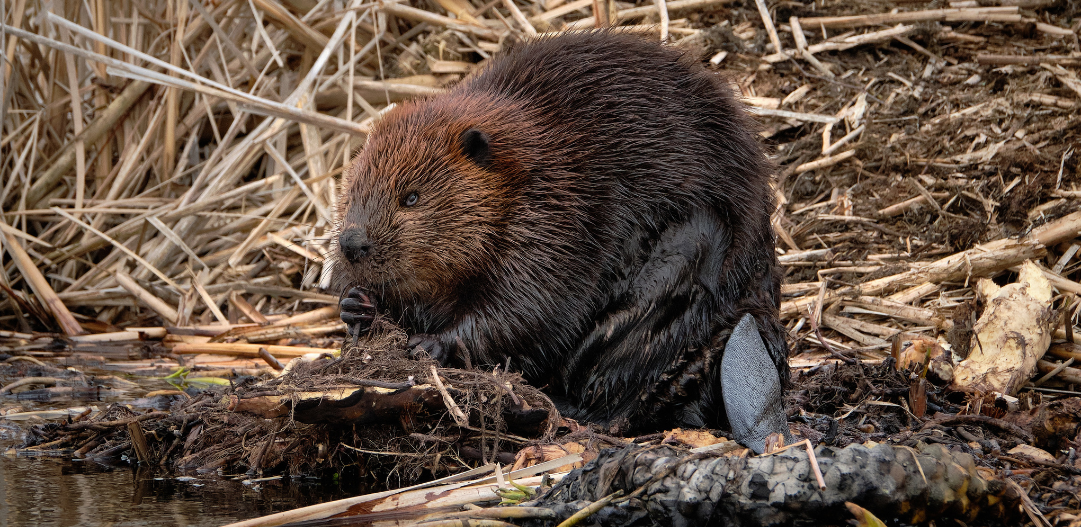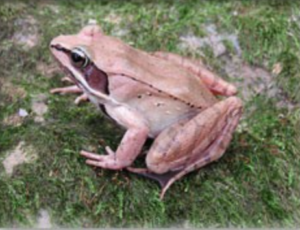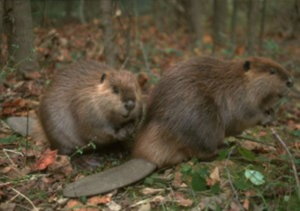
Learn how critters migrate, hibernate or adapt!
Brr! It’s cold outside! When the temperatures drop, we have many options to stay warm. Some people wear thick sweaters and wool socks, some turn up the thermostat, and others go somewhere tropical for the winter months. Have you ever wondered what the critters around us do to handle the cold? Animals have three options to survive the winter: migrate, hibernate, or adapt. Keep reading to learn an example of each from an animal you might see in our parks!
Migrate: Sandhill Cranes (Antigone canadensis) 
Sandhill Cranes eat a diet of fish and need shallow water to search for their food. They cannot cope with ice, even a thin layer that melts quickly. In Indiana, our shallow waters often freeze over so their only option is to migrate to a warmer climate for the winter. Migration is hard work! These birds will fly over 600 miles to get to their winter homes. To fuel up for this flight, they will add up to 50% of their body weight as additional fat. You can watch and listen for Sandhill Cranes as they begin migrating south from October to December, with the peak in mid-November. Once their journey is finished, they spend the winter in Florida, Texas, and northeastern Mexico.
Hibernate: Wood Frog (Rana sylvatica)
Reptiles and amphibians are ectotherms, which means their body temperature is controlled by the environment around them. When the weather turns cold, their metabolism slows almost to a stop. For creatures like this, hibernation is their only choice to survive until spring. Reptiles and amphibians look for shelter from freezing temperatures under logs, in protected rock crevices, or in the burrows of other animals.  Frogs and toads will use their hind legs to bury themselves up to 3 feet deep in soft mud. Some frogs, like Wood Frogs, can tolerate very cold temperatures. They produce a special chemical, called glycerol, which functions like anti-freeze. This chemical replaces some of the water in their cells which can keep them from freezing solid. Talk about a chill frog!
Frogs and toads will use their hind legs to bury themselves up to 3 feet deep in soft mud. Some frogs, like Wood Frogs, can tolerate very cold temperatures. They produce a special chemical, called glycerol, which functions like anti-freeze. This chemical replaces some of the water in their cells which can keep them from freezing solid. Talk about a chill frog!
Adapt: Beavers (Castor canadensis)
Adaptations to survive the winter cold vary significantly between animals. Rabbits increase the thickness of their fur. Non-migratory birds shiver all winter long. Beavers adapt their homes (lodges) to stay warm and stockpile food. Although all beavers can build an open-water lodge, most beavers in Indiana build burrows along the banks of ponds and streams. These homes have tunnels that lead from the bank, below the water, and into a nest chamber above the water level.  Beaver families are made up of one adult male, one adult female, and their offspring. They spend most of the winter inside their lodge with their family to stay warm. Beavers create a stockpile of branches they can use as food that they store underwater. When the surface water freezes, they can swim from their lodge to the brush pile and still have access to fresh food. Beavers are well adapted to stay warm and fed during the long winter months.
Beaver families are made up of one adult male, one adult female, and their offspring. They spend most of the winter inside their lodge with their family to stay warm. Beavers create a stockpile of branches they can use as food that they store underwater. When the surface water freezes, they can swim from their lodge to the brush pile and still have access to fresh food. Beavers are well adapted to stay warm and fed during the long winter months.
Do you enjoy learning about nature and the animals who call our parks home? Then you might enjoy our nature programs! You can learn more and register here: https://www.carmelclayparks.com/programs/nature/
SOURCES
https://www.in.gov/dnr/fish-and-wildlife/wildlife-resources/animals/sandhill-cranes/
https://birdsoftheworld.org/bow/historic/bna/sancra/2.0/introduction
https://www.in.gov/dnr/fish-and-wildlife/wildlife-resources/animals/beaver/
https://www.in.gov/dnr/fish-and-wildlife/wildlife-resources/animals/wood-frog/
Beaver Lodge photo: https://commons.wikimedia.org/wiki/File:Beaver_lodge_-_panoramio.jpg
Life In the Cold by Peter J. Marchand
